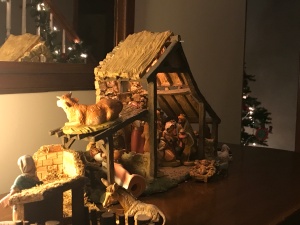“There must be some way out of here“. (Bob Dylan)
February 2024: There are many ways to revisit a place and there are many ways to leave a place. And sometimes you have to revisit a place in order to finally leave it. I never had interest in returning to the salmon-colored, concrete block basement, but found myself “transported” there. Shortly after I arrived, I noticed small packages in the room. Inside the packages were books of wisdom and philosophy. Somehow the books inside the packages were actually larger than the packages themselves. These books must get bigger with use. I recognized these books and placed them carefully on the desk at the back of the room.
Summer 1967: The salmon-colored concrete basement was a retreat from what was happening upstairs. While the basement was a retreat, it was also a prison. You could go upstairs, but you were not welcome. Scorn and contempt drove you back to the basement to find some peace – and there you stayed. That’s how the basement also became a place of conditioning. The fact that you were not welcome upstairs gradually conditioned you to believe you were not welcome anywhere.
Spring 1964: Scott was in first grade. Mrs. Lager was deeply committed to teaching kids to read, write, and think. She assigned each student to write about a classmate. Scott’s paper was about a boy named David. In the middle of his paper he wrote: “David reads with the tigers” (this was not a metaphor, but a reference to the classroom reading group David was assigned to). Scott took the paper home, but with a large family and many school papers coming through the door, the story was lost.
September 1963: David began first grade. He was a six-year-old neglected kid with dirty clothes, poor social skills, and a speech impediment. David noticed Mrs. Lager didn’t retreat from him the way other adults did. She wanted to ensure every kid coming to her classroom would learn to read by the end of the year. So — David learned to “read with the tigers”. (This was an actual reading group and a metaphor.)
Summer 1990: David begins to “read with the tigers”. (This is a metaphor, not the reading group.) The “tigers” are writers and thinkers of substance.
2017: A family was remodeling a home. They opened up a wall and found what looked like an old school paper. They called the previous owner of the house and asked if she wanted it. This turned out to be Scott’s first grade paper from over 50 years ago.
November 13, 2017: Scott sent David a photo of the 53-year-old school paper.
February 1, 2018: Scott sent the original school paper in a gold frame to David for his birthday.
February 11, 2024: David finished his visit to the basement (remember, there are many ways to revisit a place). He walked out of the basement and when he reached the top of the steps, he looked to the right at the “forbidden” upstairs. David has “read with the tigers” for a long time now, but this is the first time he realized the upstairs was where the real prison was and where the real prisoners were kept. He walked out the door.
February 12, 2024: David continues to “read with the tigers”.
February 13, 2024: David reflects on how grateful he is for a teacher who believed a neglected six-year-old could learn to “read with the tigers”.

